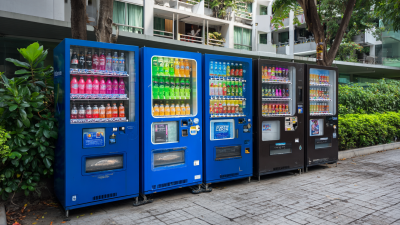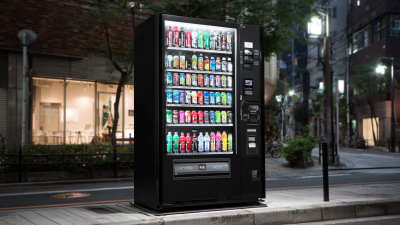Menu
Contact Us: 416.615.1555 | sale@booksvendingmachine.com
Menu
Contact Us: 416.615.1555 | sale@booksvendingmachine.com
In recent years, the vending machine industry has experienced a significant resurgence, offering entrepreneurs an appealing opportunity to capitalize on passive income streams. According to a report by IBISWorld, the vending machine sector has surged to a market size of $7 billion in the U.S. alone, with a steady annual growth rate of about 2.9%. This growth is driven by innovation within the industry—prompting many to consider the lucrative prospect of owning a vending machine. The shift towards healthier snack options and cashless payment systems aligns with consumer preferences, making it an ideal time to own a vending machine.

As the demand for convenience continues to rise, business owners are finding that owning a vending machine can be a low-maintenance venture with competitive profit margins. Data from the National Automatic Merchandising Association indicates that vending machine operators can earn anywhere from $150 to $500 per machine each month, depending on location and product offerings. This guide aims to provide a comprehensive overview for prospective entrepreneurs, detailing what it takes to successfully own a vending machine, from selecting the right machines and products to navigating industry regulations and maximizing profits in 2023. Unlocking the potential within this resilient market may just be the key to achieving financial independence.
The vending machine market is undergoing significant transformation, presenting lucrative opportunities for entrepreneurs in 2023. With a projected growth from $11.47 billion in 2025 to $36.89 billion by 2032, at an impressive CAGR of 18.2%, the industry is positioned for expansion. This growth is fueled by advancements in technology, shifting consumer preferences, and the increasing demand for convenient, contactless purchasing options.
Key trends influencing the market include the rise of smart vending machines, which utilize IoT technology to enhance user experiences and optimize inventory management. These machines can track consumer behavior, allowing for personalized product offerings that can lead to higher sales. Additionally, the global trend towards healthier snack options is prompting operators to diversify their selections, aligning with consumer demands for nutritious choices. As the market evolves, those looking to invest in vending machines must stay informed about emerging technologies and consumer trends to capitalize on the growing demand in this innovative space.
When considering starting a vending machine business in 2023, selecting the right machines is crucial to your success. There are various types of vending machines on the market, each catering to different products and customer needs. Traditional snack and beverage machines are often the go-to for many entrepreneurs, but options like healthy vending machines, coffee machines, and even specialized machines for items like electronics or personal care products can also capture niche markets. Understanding your target audience will guide you in choosing the right type based on location and demand.
In addition to the type of machine, features play a significant role in maximizing profitability. Look for machines with cashless payment options, as consumers increasingly prefer to use credit cards, mobile wallets, and contactless payments. Machines equipped with digital displays can enhance customer engagement by showcasing promotions or nutritional information. Furthermore, smart technology that tracks inventory and sales data can streamline your operations and provide insights to optimize product offerings. By carefully considering these features, you can ensure that your vending machine business remains competitive and aligned with current consumer preferences.
Finding the right location is crucial for operating a successful vending machine business in 2023. With the rise of convenience-driven consumer behavior, smart entrepreneurs are leveraging data analysis to identify prime spots for their machines. According to industry reports, locations such as office complexes, schools, gyms, and hospitals provide high foot traffic and increased sales opportunities. For example, research indicates that vending machines in fitness centers can generate up to 20% more revenue compared to those placed in less frequented areas.
In addition to traditional locations, there is an interesting trend emerging with specialized vending machines, such as healthy snack options. The growing preference for health-conscious choices among consumers is reflected in the popularity of juice vending machines, which have gained significant traction. Reports suggest that this shift towards healthier options can lead to a 30% increase in profits, as consumers are increasingly seeking convenience without compromising their dietary preferences. By strategically placing machines in areas frequented by health-conscious individuals, entrepreneurs can optimize their returns while catering to market demand.

Effective inventory management is crucial for maximizing product sales and minimizing waste in the vending machine business, particularly in light of the evolving consumer preferences toward fresh and convenient food options. As trends indicate a growing demand for ready-to-eat baked goods, operators should focus on stocking a variety of items that cater to these preferences. This not only increases sales potential but also reduces the likelihood of inventory becoming stale. Utilizing technology to track inventory levels in real-time can help identify popular items and adjust restocking frequencies, ensuring that the offerings remain fresh and appealing.
In the context of sustainable practices, vending machine businesses must also consider the impact of their operations on the environment. Emphasizing a business model that minimizes waste aligns with the global push for resource management and sustainability. Incorporating eco-friendly practices, such as promoting products with lower carbon footprints or sourcing ingredients responsibly, can enhance brand loyalty among environmentally conscious consumers. Moreover, leveraging data analytics to predict trends and consumer behavior helps in making informed decisions that not only optimize inventory but also contribute positively to the ecosystem.
| Product Category | Average Monthly Sales | Restock Frequency (Days) | Waste Percentage | Profit Margin (%) |
|---|---|---|---|---|
| Snacks | $1,200 | 7 | 5% | 30% |
| Beverages | $1,500 | 5 | 3% | 35% |
| Healthy Snacks | $800 | 10 | 10% | 25% |
| Gum & Mints | $400 | 14 | 2% | 50% |
| Instant Meals | $600 | 8 | 7% | 20% |
To attract and retain customers in the competitive vending machine industry, effective marketing strategies are crucial. One of the first steps is to identify your target audience and place your machines in high-traffic locations such as office buildings, schools, and recreational facilities. Consider investing in location analysis tools or software to pinpoint areas with significant foot traffic. Additionally, using social media platforms to promote your machine offerings can help you engage with potential customers and build a community around your brand.
Product selection plays a vital role in customer retention. Offering a diverse range of snacks and beverages that cater to various dietary preferences, such as healthy snacks or vegan options, can attract a broader audience. Implementing a loyalty rewards program can encourage repeat customers, making them feel valued and more likely to return for their favorite items. Regularly refreshing your inventory based on customer feedback and seasonal trends will keep your offerings relevant and appealing, ensuring that your vending machine business stays profitable in 2023 and beyond.






